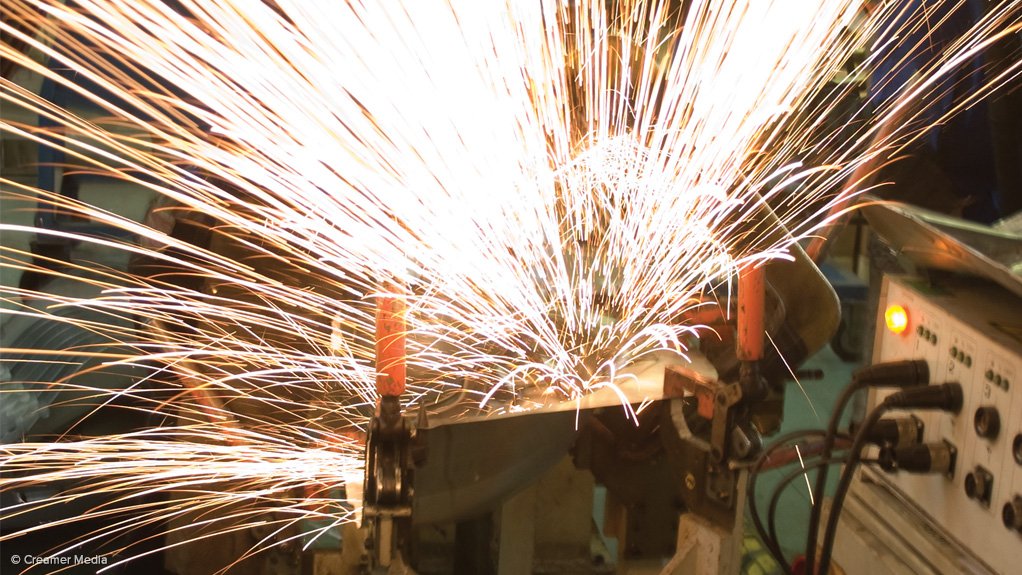Manufacturing production declined by less than expected in April, with total output falling by 1.5% year-on-year, Statistics South Africa (Stats SA) revealed on Tuesday.
The main contributors to this decline were the motor vehicles, parts and accessories and other transport equipment and the petroleum, chemical products, rubber and plastic products divisions, which declined by 13.2% and 5.3% year-on-year respectively.
BNP Paribas economist Jeffrey Schultz said that, while the April figures showed an “upside surprise”, it was “still nothing to get excited about” when compared with March’s upwardly revised 1% growth.
Banking group Nedbank’s economic unit pointed out that the market had expected a 5.5% year-on-year drop in output owing to weak underlying conditions and base considerations.
Schultz, however, noted that, while the contraction in April’s manufacturing production growth was not as severe as what BNP and the rest of the market had expected, it nevertheless continued to paint a picture of an industry under severe pressure.
“Elevated input cost pressures, still weak domestic demand conditions and the negative knock-on effects from the more than five-month-long strike in the platinum group metals sector remain a handbrake on the country’s industrial production outlook. The deterioration in key local performance management indices in recent months and heavily depressed levels of business confidence, support this view,” he said.
Meanwhile, seasonally adjusted manufacturing production declined by 1.8% for the three months ended April, compared with the previous three-month period, with six out of the ten manufacturing divisions having reported negative growth rates over this period.
Schultz noted that this measure could, in months to come, be used to gauge the likelihood of South Africa entering its second consecutive quarter of negative quarterly gross domestic product growth.
The largest negative contributions to the 1.8% decrease were made by the petroleum, chemical products, rubber and plastic products segment, which declined by 5.2% and contributed a negative 1.2 percentage points and the motor vehicles, parts and accessories and other transport equipment division, where output declined by 7.4% and contributed a negative 0.7 of a percentage point.
Investec economist Kamilla Kaplan stated that the declines in year-on-year and quarter-on-quarter production showed a worsened situation in the production side of the economy, particularly with the platinum strike ongoing.
"The Rand Merchant Bank and Bureau of Economic Research business confidence index for the second quarter confirmed business confidence in the manufacturing sector has dropped to the lowest level since 2009. Low levels of business confidence are associated with weak output levels, and by extension, limited fixed investment and job creation," she said, adding that the worsening quarterly contraction in manufacturing production in April maintained the risk of recession.
Further, Stats SA noted that seasonally adjusted month-on-month basis production increased by 3.5%, with eight of the ten manufacturing subdivisions registering positive production growth in the month.
The largest contributions to this increase came from food and beverages production, which climbed 7.8% month-on-month, basic iron and steel production, which increased by 3.4%, and wood and paper products production and motor vehicles, parts and accessories production which increased by 3.3% and 3.9% respectively.
“While the trends in manufacturing activity over the next two months will be closely scrutinised, we see little evidence in the economy to suggest a sizable base-effect-induced bounce in production growth in the coming months.
“At best, we see a quarterly growth increase in the low single digits likely for this side of the economy in the second quarter, with a large degree of downside risk to this assertion,” Schultz said.
Meanwhile, Stats SA also stated that the seasonally adjusted sales of manufactured products at current prices increased by 0.6% or R2.57-billion in the three months ended April, compared with the previous three months.
The manufacturing divisions that were mainly responsible for the increase in total manufacturing sales were basic iron and steel, nonferrous metal products, metal products and machinery that showed a 3.1% increase and food and beverages of which the sales went up 2%.
Sales in the petroleum, chemical products, rubber and plastic products division declined by 3.7% – a major negative contributor, Stats SA said.
STEEL
Following the release of April’s manufacturing production figures, Steel and Engineering Industries Federation of Southern Africa chief economist Henk Langenhoven said the steel and engineering sector had shown continued improvement since the beginning of 2014.
Production for the first four months of the year was 1.3% better than the 2013 comparable period.
“What is even more encouraging is that [production in] April was 4.3% more than [that of] March, which shows an acceleration of the improvement,” Langenhoven said.
When a full year ending in April was compared with a similar 12 months earlier, the sector grew by 3.5%.
Langenhoven was optimistic that the sector would achieve better growth during 2014 than the meagre 2% achieved during 2013; however, he warned that instability in the data was still evident.
Langenhoven also noted that production in the month of April was 2% lower than in the same month last year.
Futrher, he cautioned that the short-term confidence indicators, such as the Purchasing Managers’ Index and Bureau for Economic Research’s current conditions in manufacturing still pointed to uncertainty and could translate into a slowdown in actual production. This was despite the signs from actual production figures being positive.
EMAIL THIS ARTICLE SAVE THIS ARTICLE
To subscribe email subscriptions@creamermedia.co.za or click here
To advertise email advertising@creamermedia.co.za or click here











